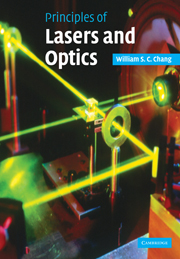Book contents
- Frontmatter
- Contents
- Preface
- 1 Scalar wave equations and diffraction of laser radiation
- 2 Gaussian modes in optical laser cavities and Gaussian beam optics
- 3 Guided wave modes and their propagation
- 4 Guided wave interactions and photonic devices
- 5 Macroscopic properties of materials from stimulated emission and absorption
- 6 Solid state and gas laser amplifier and oscillator
- 7 Semiconductor lasers
- Index
- References
3 - Guided wave modes and their propagation
Published online by Cambridge University Press: 06 July 2010
- Frontmatter
- Contents
- Preface
- 1 Scalar wave equations and diffraction of laser radiation
- 2 Gaussian modes in optical laser cavities and Gaussian beam optics
- 3 Guided wave modes and their propagation
- 4 Guided wave interactions and photonic devices
- 5 Macroscopic properties of materials from stimulated emission and absorption
- 6 Solid state and gas laser amplifier and oscillator
- 7 Semiconductor lasers
- Index
- References
Summary
In Chapters 1 and 2 we discussed the propagation of laser radiation and the cavity modes as TEM waves. The amplitude and phase variations of these waves are very slow in the transverse directions. However, in applications involving single-mode optical fibers and optical waveguides, the assumption of slow variation in the transverse directions is no longer valid. Therefore, for electromagnetic analysis of such structures, we must go back to Maxwell's vector equations. Fortunately, the transverse dimensions of the components in these applications are now comparable to or smaller than the optical wavelength; solving Maxwell's equations is no longer a monumental task.
Many of the theoretical methods used in the analysis of optical guided waves are very similar to those used in microwave analysis. For example, modal analysis is again a powerful mathematical tool for analyzing many devices and systems. However, there are also important differences between optical and microwave waveguides. In microwaves, we usually analyze closed waveguides inside metallic boundaries. Metals are considered as perfect conductors at most microwave frequencies. In these closed structures, we have only a discrete set of waveguide modes that have an electric field terminating at the metallic boundary. We must avoid the use of metallic boundaries at the optical wavelength because of their strong absorption of radiation. Thus, we use open dielectric waveguides and fibers in optics, with boundaries extending theoretically to infinity. These are open waveguides. There are three important differences between optical and microwave waveguide modes and their utilization.
- Type
- Chapter
- Information
- Principles of Lasers and Optics , pp. 72 - 113Publisher: Cambridge University PressPrint publication year: 2005

